Rosemarket is a small village, located in a picturesque area of South-West Pembrokeshire, four miles North East of Milford Haven. The village contains two War Memorials; the Parish Church of St. Ishmael’s holds an oak panel, with the names of six men who were killed in the Great War, plus those who served and returned. Beneath this is a smaller oak plaque, dedicated to the four men of the Parish who fell during the Second World War. The memorial Hall contains two marble plaques, which were formerly housed within Rosemarket Tabernacle Chapel, which commemorate the six men who fell during the Great War, and the four men of the Second World War. I have also added the details of several men connected to the Parish, who are not named on any of these memorials, as well as the men who survived the war, with as many details as I can presently find. Many thanks to Mr. David Wildman for kindly sending me several photographs of these memorials, for use on this page.
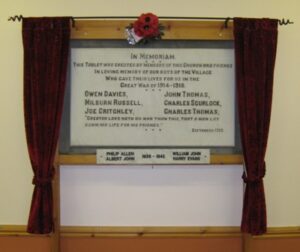
The Great War, 1914-1918
Joseph Critchley, Private, 17044, East Lancashire Regiment. Joseph was born at Oldham, Lancashire on 6 April 1894, the son of Edwin Critchley and Rachel Critchley (nee Wrigley). He left home to work at Barn Farm, Barn Lane, Rosemarket in around 1912, as a live in farm-boy, and was regarded as one of the family by John Pawlett and Mary Pawlett (nee Barrah), his employers. Joseph enlisted at Haverfordwest into the army, and was posted to the 8th Battalion, East Lancashire Regiment, which was attached to 112 Brigade, 37th Division. Late in July 1915 the Division landed in France and concentrated near St Omer by 2 August 1915. It saw its first major action during the attack at Gommecourt during the first phase of the Battle of the Somme, suffering heavy casualties during a needless diversionary assault. Two of its brigades, 111 Brigade and 112 Brigade were then temporarily attached to the 34th Division and were thrown into the bloody fighting for Pozieres Ridge. Joseph’s battalion left Becourt Wood on 7 July and marched into the battle zone, moving into support positions at Heligoland. Three days later the battalion advanced towards Pozieres and consolidated an existing trench before attempting to enter the village itself, in co-ordination with an assault by the Australians. Joseph was killed in action during a second assault on Pozieres village on the following morning, 15 July 1916. The 22-year-old has no known grave and is commemorated on the Thiepval Memorial, France.
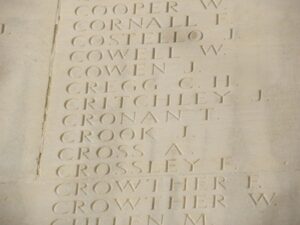
Andrew Redvers Davies, Private, 42745, Norfolk Regiment. Andrew was born in 1900, the son of James Davies and Elizabeth Davies (nee Venables), of Colwyn House, Rosemarket. He enlisted into the army as soon as he turned eighteen and was posted to the Norfolk Regiment. Andrew did not serve overseas, as the Armistice was signed before he had completed his training. He contracted tuberculosis whilst training and was discharged from the army as medically unfit on 29 November 1919, just over a year after the Armistice. He returned home to Rosemarket where he died of tuberculosis on 1 February 1923, aged 23. Andrew is not commemorated by the CWGC, as he died too late for commemoration. His brother, Owen, had been killed in France in 1917.
John Davies, Rifleman, 48376, London Regiment. John was born at Haverfordwest in 1882, the son of John Davies and Ann Davies. He trained as a monumental mason, before moving with his widowed mother to 10, Rock Street, Mountain Ash, where he ran his own business. John married Rhoda Margaret Brown, of The Shop, Hill Mountain on 4 March 1917. Rhoda was a schoolteacher at Rosemarket School. John had enlisted at Mountain Ash into the South Wales Borderers, with the Regimental Number 30486. He later transferred into the 1/28th Battalion (Artists Rifles), London Regiment, which was attached to 190 Brigade, 63rd (Royal Naval) Division. The division saw its first major action during the Second Battle of Passchendaele in October 1917, where heavy casualties were suffered during terrible conditions. The division was then transferred to the Arras sector and took place in the Battle of Cambrai, seeing especially heavy fighting during the Action of Welsh Ridge. The division was still in the area when the Germans launched their Spring Offensive on 21 March 1918 and took part in a gallant rear-guard action as the line was driven back by the Germans. The Germans then switched their attention away to the Lys Valley on 9 April and the sector held by the Royal Naval Division at the Northern edge of the Somme sector quietened down. John was killed in action whilst the Artist’s Rifles were holding a section of the line in Aveluy Wood on 1 June 1918. The 36-year-old is buried in Varennes Military Cemetery, France. John is not commemorated on either of the Rosemarket war memorials.
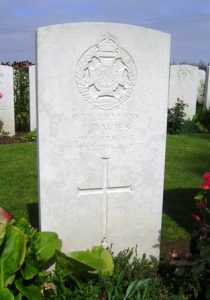
Owen Davies, Private, PS/9974, Royal Fusiliers. Owen was born in 1890, the son of James Davies and Elizabeth Davies (nee Venables), of Colwyn House, Rosemarket. He served his apprenticeship as a Grocer at Neyland, before moving to Abertillery prior to the war, to work as a grocer’s assistant in the town. Owen returned home to enlist at Haverfordwest into the army soon after the outbreak of war. Upon completing his training, he was drafted to France early in 1916, and was posted to the 17th (Empire) Battalion, Royal Fusiliers, which was attached to 5 Brigade, 2nd Division. Owen would have fought at the Battle of the Somme that summer. The division wintered on the Somme, then followed the German retreat to the Hindenburg Line in early 1917. Owen’s battalion spent several days training at Pernes at the end of March 1917 before moving to Maroeuil on 10 April, taking over reserve positions north of Roclincourt, in readiness for the forthcoming Arras offensive, and two days later moved into some old German trenches before taking over the front line, which consisted merely of some isolated posts on the Arras to Arleux Road, adjacent to the Canadian Corps. Over the coming days a number of raiding parties were sent out to reconnoitre the ground in front of the battalion, as preparations continued for the great offensive to come, then on 18 April the battalion was relieved and moved into reserve to enjoy a brief rest before the battle. On 25 April the battalion received its orders, to assault the Oppy Line and Arleux Switch Line, then spent the following day equipping before taking over the front line again. At dawn on 28 April 1917 the battalion left its trenches and swarmed across No Man’s Land to assault the strongly defended German lines. The left flank, besides the Canadians, did well, but the right flank suffered due to the neighbouring units not attaining their objective of Oppy and large amounts of casualties were suffered as a result. Owen was killed in action during the fighting that day, on 28 April 1917. The 27-year-old has no known grave and is commemorated on the Arras Memorial, France. His brother, Andrew, died in 1923 of sickness contracted on active service.
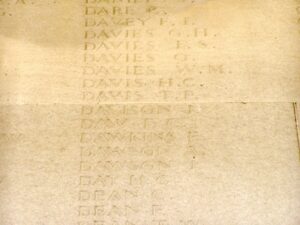
John Henry Nicholas, Private, 62877, Lancashire Fusiliers. John was born in Newport, Monmouthshire in 1899, the son of Oliver Nicholas and Ann Nicholas (nee Llewellyn). His parents were from Rosemarket, but after marrying in 1897 had moved to 8, Rutland Place, Newport, where Oliver worked as a Boilermaker. John’s mother, Ann, died in 1907, and his father remarried to Agnes Hughes in 1911. John worked as a labourer prior to enlisting into the Welsh Guards at Harlech on 30 May 1917 but was discharged as medically unfit just two months later. Undeterred, he re-enlisted at Newport into the army, and was drafted to France in the autumn of 1917, before being posted to the 18th Battalion, Lancashire Fusiliers, which was attached to 104 Brigade, 35th Division. John joined the battalion at Ypres and would have taken part in the Second Battle of Passchendaele, the final stages of the Third Battle of Ypres. The division wintered in the Ypres Salient but following the launching of the German Spring offensive on the Somme front on 21 March 1918 was transferred south, entraining at Poestlehoek on 23 March before detraining at Heilly, in the Somme Valley, to bolster the beleaguered Allied forces which had been driven back by the Germans over the preceding days. John’s battalion took over a section of the line between Sailly-Lorette to Morlancourt and was immediately thrown into desperate fighting upon moving into position on 26 March. The division then held the line, stemming the German advance across the River Ancre, before being relieved by the Australians on 31 March and moved back into reserve at La Houssoye. On 4 April the division took over the line defending the Somme Canal near Corbie and its infantry battalions began carrying out the usual routines of trench rotation, as the Germans had switched their attention further north, to the Lys Valley. The 35th Division then moved into positions near Bouzincourt, next to the 38th (Welsh) Division, where it remained over the coming months. John was killed in action here when his battalion was subjected to a terrible German artillery bombardment on 14 June 1918, which killed over fifty men. The 19-year-old has no known grave and is commemorated on the Pozières Memorial, France. John is not named on either of the Rosemarket Memorials.
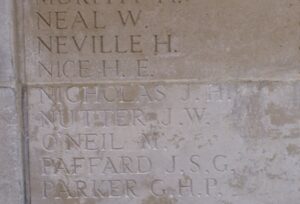
Joseph John Russell, Private, 29092, South Wales Borderers. Joseph was born in Rosemarket in 1891, the son of George Russell and Elizabeth Russell (nee James). He worked as a farm labourer prior to the war. Joseph married Jennie Kelly, of Freystrop, in 1915, just after having enlisted into the army. He was drafted to France in the spring of 1917, and was posted to the 2nd Battalion, South Wales Borderers, which was in the Arras sector attached to 87 Brigade, 29th Division. The division had suffered heavy losses for the gruesome fighting for Monchy-le-Preux in April 1917, during the Battle of Arras, and after rebuilding moved to the Ypres Salient in June, initially to hold the line whilst other units had been withdrawn for specialist training, in readiness for the Third Battle of Ypres, which opened on 31 July 1917. The 29th Division went into reserve whilst the first attacks, the Battle of Pilckem Ridge, took place, then on the night of 14-15 August the 2nd SWB moved into the line facing Langemarck. The division then saw heavy fighting during the coming months at Ypres, before being transferred to the Cambrai Sector, to take part in the Battle of Cambrai, another ill-fated Allied offensive. The division wintered in the Cambrai sector, then in January 1918 moved to Ypres again. Following the launching of a second German offensive, on the Lys, on 9 April, the 29th Division was relieved from Ypres and moved south to bolster the thinly stretched British lines, suffering terrible casualties over the coming days. Joseph survived the war, but by the time he returned to Britain his health was failing and he was discharged from the army on 26 April 1919, suffering from tuberculosis, deemed to have been contracted on active service. He returned home to his wife Jennie at Middle Street, Rosemarket, but his health continued to wane and Joseph died on 21 April 1924. He is not commemorated as a casualty of war by the CWGC as he died too long afterwards, but it was his time in France that eventually led to his early death at just 33 years old. His brother, Melbourne George Russell, died of wounds in France in 1918.
Melbourne George Russell, Private, 202940, South Lancashire Regiment. George was born at Rosemarket in 1897, the son of George Russell and Elizabeth Russell (nee James). He enlisted into the army, and was posted to the 2/4th Battalion, South Lancashire Regiment, which was attached to 172 Brigade, 57th (2nd West Lancs) Division. The Division moved to France during February 1917, and moved to the Nursery Sector at Erquinghem, for trench initiation and training alongside the Australians. The division then took over the Rue de Bois Sector where it remained over the coming months, before being transferred to positions near Ypres at the beginning of October, where it took part in the Second Battle of Passchendaele. The division moved back to the Erquinghem area for the winter, and took part in the heavy fighting which followed the launching of the German offensive on the Lys from 9 April 1918. The division was then transferred south, taking over positions near Gommecourt and remained here until the beginning of August when it was transferred to the Arras Sector. The division then took part in the great Allied offensive which was launched on 21 August 1918, launching its assault from the Fampoux Sector towards the Hindenburg Line and saw heavy fighting during the Battle of the Scarpe, and at the Battle of Drocourt-Queant. Following the breaking of the Hindenburg line, the Division took part in the great advance towards Cambrai, helping capture the city. George was wounded near Fontaine-Notre-Dame, during the attack on Cambrai, and was evacuated to the 19th Casualty Clearing Station, where he died of gas gangrene to his wounds on 5 October 1918
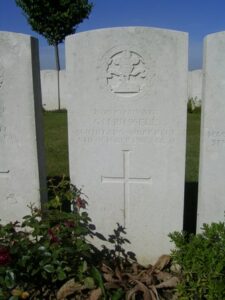
Richard Charles Scurlock, Private, 226554, Monmouthshire Regiment. Richard was born on 29 April 1885, the son of Richard Scurlock and Lettice Scurlock (nee Matthias), of Front Street, Rosemarket. He worked as an engine cleaner for the GWR prior to leaving home to enlist into the Royal Navy on 5 August 1903 and was posted to HMS Vivid for training. Richard served for the next four years, and had several postings during that time, aboard HMS Essex; HMS Blake; and HMS Leander, before leaving the Navy in November 1907. He then moved to Abertysswg where he found work as a colliery haulier and married Lily Heggie there on 11 April 1910. The couple set up home together at 71, Charles Street, Abertysswg, where their two children: Richard and Edith, were born. He enlisted into the South Wales Borderers at Newport on 1 September 1914 and was posted to the Depot at Brecon Barracks. He was discharged from Brecon as medically unfit on 5 November and returned to Newport, where he re-enlisted into the Monmouthshire Regiment. Richard was drafted to France in the summer of 1916, joining the 1st Battalion, Monmouthshire Regiment, which was by then the Pioneer Battalion to the 46th (North Midland) Division, and was on the Somme. Here the Division took part in the Attack on the Gommecourt Salient, which was a diversionary attack on 1 July 1916 intended to draw attention away from the main attack on the Somme, but large numbers of casualties were suffered during the attack. The division rested for several months at Arras, and at the end of 1916 returned to the Somme and took part in a series of minor operations on the Ancre. During March 1917 the Division followed the German Retreat to the Hindenburg Line, and then fought in the Battle of Arras, taking part in the Battle of Hill 70, near Loos. Richard must have been attached to another unit after this, as he was killed in action at Ypres on 24 June 1917, whilst the 1st Monmouth’s were still at Lievin, in the Loos area. The 30-year-old is buried in Vlamertinghe New Military Cemetery, Belgium.
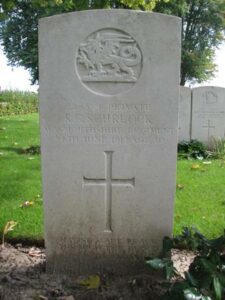
James Charles Thomas, Private, 85944, Machine Gun Corps. James, known as Charles, was born in 1891, the son of James and Ann Thomas, of Talyhoo Farm, Llangwm. He lived in Rosemarket prior to the war. James enlisted at Pembroke into the Welsh Regiment at the outbreak of war, being allotted the service number 6462. Charles was then transferred into the 235th Company, Machine Gun Corps, which was attached to the 12th (Eastern) Division. The Division landed at Boulogne on 31 May 1915, and took over the line at Ploegsteert Wood. It then moved south and fought in the Battle of Loos, and the subsequent actions of the Hohenzollern Redoubt. The division wintered in the Loos sector, but in March 1916 moved south to the Somme. The division attacked the village of Ovillers on 2 July, suffering heavy casualties before it was relieved. It then saw further fighting at Pozières and Le Transloy before being moved to the Arras area during October 1916. The division then fought in the Arras offensive the following Spring, taking part in the First Battle of the Scarpe, and the Battle of Arleux. It then fought at the Third Battle of the Scarpe and helped capture the heavily defended village of Roeux. The Division remained at Arras until taking part in the Battle of Cambrai in November 1917. Charles was wounded and taken prisoner at Cambrai in November, and died of his wounds in captivity on 4 December 1917. The 26-year-old was buried by the Germans in Caudry, in what is now named Caudry British Cemetery, in France.
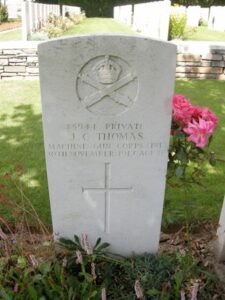
John Thomas, Private, 54088, Welsh Regiment. John was born in 1895, the son of Phillip Thomas and Anne Thomas, of Beaconing, Rosemarket. He worked as a farm labourer as a young man, before heading to the South Wales valleys to find work as a coalminer. John married Florence Louise Gaytten in 1914 and the couple set up home at 24, Burn Street, Cwmaman, Aberdare, where their two children, Philip and Violet, were born. John enlisted into the Welsh Regiment at Aberdare in 1916 and was posted to the 17th Battalion, Welsh Regiment, which was attached to 119 Brigade, 40th (Bantam) Division. Early in June 1916 the division moved to France, initially to positions around Lillers before taking over the North Maroc Sector, near Loos, for trench initiation and once acclimatised was left to hold the sector itself over the coming months. The infantry battalions of the Division then began the usual routines of rotating for duty in the trenches: normally four days in the front line; four in support and four in reserve. Late in 1916 the Division moved south to the Somme, and fought at the Battle of the Ancre, before remaining in the sector over the winter. In March 1917 the Germans withdrew to their shortened line, called the Hindenburg Line, and the 40th Division was among the units which followed the withdrawal. John was killed during a trench raid near Gonnelieu on 12 July 1917. The 22-year-old is buried in Fins New British Cemetery, Sorel-Le-Grand, France.
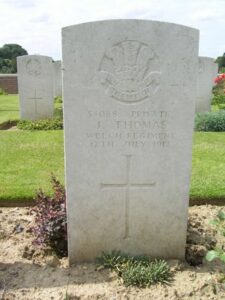
World War Two, 1939-1945
Phillip James Allen, Engineman, LT/265 E.U., Royal Naval Reserve (Patrol Service). Phillip wwas born in Cardiff on 4 January 1899, the son of William Allen and Anne Allen (nee Elliott). By 1911 the family had moved to 15, Marble Hall, Milford Haven. Philip had enlisted at Milford into the Royal Naval Volunteer Reserve and had served during the Great War. He married Mary Ann Bowen, of Neyland in 1923, but Mary died in 1928, and in 1933 Philip married Elsie May Picton. Philip continued to serve with the Royal Naval Volunteer reserve between the wars and was a very experienced and capable sailor. When the Second World War erupted he re-joined the colours and served with the Royal Naval Patrol Service aboard HM Trawler Lord Inchcape, a Hull registered Trawler, which had been taken over by the Admiralty in August 1939. She was sunk on 25 October 1940 after hitting a mine, but was raised and repaired, and saw further service during the war on anti-submarine duties and minesweeping. Philip was later posted to HMT Monique Andree, which was based at Lowestoft. Philip died of myocardial degeneration whilst on active service at Falmouth on 20 August 1943. The 44-year-old is buried in Falmouth Cemetery, Cornwall.
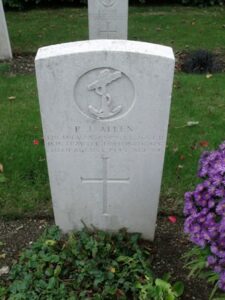
Harry Evans. This man cannot presently be identified.
George Hart, Lance Corporal, 2927097, Queen’s Own Cameron Highlanders. George was the son of John Hart and Margaret Hart, of Motherwell. He had enlisted into the Cameron Highlanders prior to the war and was a regular soldier. George married Edna Mary Bishton, the daughter of Welsh parents, whilst based near Warminster in 1938. Following the outbreak of war, George was posted to France with the 1st Battalion, Cameron Highlanders. The battalion joined the BEF on the Maginot Line, but when the Germans swept into France through neutral Holland and Belgium, the BEF was forced to withdraw towards the Channel coast, and George was evacuated from Dunkirk in May 1940. After two years on home defence duties, George’s battalion was sent to the Far East in June 1942. His wife, Edna Mary Hart, moved to Rosemarket soon afterwards. George was killed in Burma on 4 May 1944, at the height of the Battle of Kohima. The 33-year-old has no known grave and is commemorated on the Rangoon Memorial, Myanmar. George is not commemorated on either of the Rosemarket Memorials.
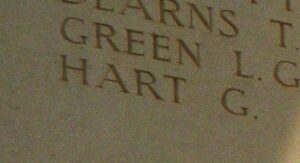
Albert Charles John, Shipwright 3rd Class, D/M 14425, Royal Navy. Albert was born on 27 November 1888, the son of John and Ellen John of Rosemarket. He was already a skilled shipwright when he enlisted into the Royal Navy on 17 July 1915 and he served all the way through the Great War and beyond, retiring in 1936 after 21 years service. Upon returning to civilian life, Albert went to live at Highmead Road, Carmarthen. He was called up in August 1939 and was posted aboard the aircraft carrier HMS Courageous. On 31 August 1939, Courageous went to her war station at Portland and embarked two squadrons of Fairey Swordfish aircraft. She left Plymouth on the evening of 3 September for an anti-submarine patrol in the Western Approaches, escorted by four destroyers. On 17 September 1939 Courageous was about to launch Swordfish when she was struck by two torpedoes which had been fired by the German submarine U-29. Courageous sank within 20 minutes, with the loss of over 500 of her crew. Albert was 50 years old when he died that day, and is commemorated on the Plymouth Naval Memorial, Devon. Albert was one of the first two Pembrokeshire men to die during WW2, the other man, Henry William Davies of Lawrenny, also served aboard Courageous.
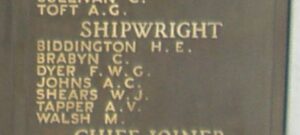
William Thomas John, Gunner, 963351, Royal Artillery. William was born on 13 October 1917, the son of John John and Emily Gladys John (nee Morgan), of Rosemarket. By 1939 William was working as a lorry driver at HM Docks, Portsmouth. He enlisted into the army soon afterwards and served with 112 Battery, 28 Light Anti Aircraft Regiment, Royal Artillery. William died at The City Hospital, Nottingham on 23 December 1940. The remains of the 23-year-old were conveyed home and he was buried in Rosemarket Congregational Chapelyard.
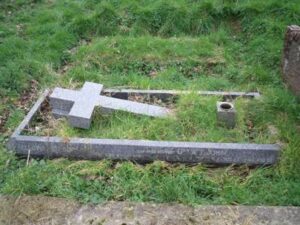
Harold Joseph Palmer, Private, 4197594, The Devonshire Regiment. Harold was born in 1917, the son of James Palmer and Rebecca Palmer (nee Cousins), of Silver Stream, Freystrop. He married Queenie Gwendoline John, of Rosemarket, in 1943, after having enlisted into the army. Harold was drafted out to the Far East soon after his marriage and was posted to the 1st Battalion, The Devonshire Regiment, which was attached to the 20th (Indian) Infantry Division. Harold died in India on 7 May 1944, during the Battle of Imphal. The 26-year-old is buried in Imphal War Cemetery, India. Harold is not commemorated on either of the Rosemarket Memorials.

Those Who Served and Returned, The Great War, 1914-1918
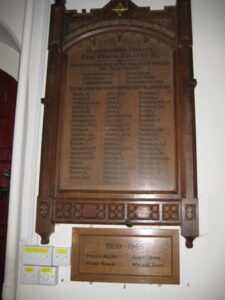
Bowen, W.
Barrah, B.
Cattanach, Alexander B. A., 160603, Gunner, Royal Garrison Artillery. (School House, Rosemarket)Davies, A.
Davies, Henry, 14288, Leading Stoker, Royal Navy, HMS Vivid. (Colwyn House, Rosemarket)
Davies, I. Royal Navy.
Davies, Jasper, M6502, Shipwright, Royal Navy, HMS Dolphin. (Colwyn House, Rosemarket)
Davies, R.
Davies, William, M7189, E.R.A., Royal Navy, HMS Platypus. (3, Church Street, Rosemarket)
Devonald, James, 126546, Private, Machine Gun Corps, 38th Battalion. (Big House, Rosemarket)
Devonald, T.
Evans, J.
Faulkener, ? Doctor.
Griffiths, Albert C., 265798, Lance Corporal, Welsh Regiment, 6th Battalion. (Bramble, Neyland)
Griffiths, W.
Harries, Archibald, 448018, Lance Corporal, Royal Engineers. (Middle Street, Rosemarket)
Hicks, ?
Hutchens, F.
John, A.
John, Albert, 287124, Royal Navy.
John, H.
John, James, 41831, Royal Navy.
John, Thomas, 114801, Royal Navy.
Jones, I.
Langdon, W, 167894, Royal Navy.
Lea, ? Captain.
Llewellyn, R.
Llewellyn, W.
Mathias, F.
Morris, Jack.
Morris, J.
Morris, R.
Mounsey, John Graham, Captain, Royal Garrison Artillery.
Phillips, J.
Phillips, R.
Picton, W.
Plattens, Thomas E, 46391, Private, Welsh Regiment. (Bramble Cottages, Rosemarket)
Redwood, H.
Rees, Victor Lewis Evan, J46487, Royal Navy.
Reynolds, A.
Reynolds, I.
Reynolds, John, 201643, Private, Welsh Regiment, 1/4th Battalion. (Westfield Mill, Rosemarket)
Russell, Melbourne George, 202940, Private, South Lancashire Regiment, 2/4th Battalion. (Rosemarket, Neyland)
Scurlock, Thomas George, M101143, Stoker, Royal Navy, HMS Crescent. (4, Front Street, Rosemarket)
Scurlock, William Henry, 106408, Royal Navy.
Sutton, H.
Sutton, J.
Summons, F.
Tobin, A.
Thomas, G. Royal Navy.
Thomas, T.
Thomas, W.
Venables, John, 48532, Private, Welsh Regiment, 1st Battalion. (Rosemarket, Neyland)
Venables, Stephen John, 182620, Sapper, Royal Engineers. (New Inn, Rosemarket)
Venables, W.
Warlow, Robert George, 2445, Lance Corporal, Welsh Guards, 1st Battalion. (Waterless Farm, Rosemarket)
Warlow, William Francis, 45702, Rifleman, Royal Irish Regiment, 4th Battalion. (Back Street, Rosemarket)
Warlow, Wm. Francis, 202212, Rifleman, Royal Irish Regiment, 16th Battalion. (Rosemarket)
Warlow, William John , 46515, Private, Welsh Regiment, 8th Battalion. (Waterless, Rosemarket)